Career Communication
How to Stop Slouching and Perfect your Posture for Communication at Work
If you’re reading this, you will likely want to show more elegance, stop slouching and feel confident in how you carry yourself. Like you, we’re on a journey to help you do that!

Many of our clients frequently ask us how to increase elegance and feel confident in carrying yourself, stop slouching and secure perfect posture, especially when interacting at work. How can we exude confidence and grace while presenting ourselves at work? Let’s dedicate some time together to consider how posture and deportment can make you an elegant communicator.
This article has been prepared by Sarah Lobegeiger de Rodriguez, director of Cadenza, speech therapist, opera singer and executive speaking consultant.
This article will show you how your body can support your message so that you can interact with increased poise and confidence when communicating at work. Carrying yourself with composure and confidence has benefits for your wellbeing, voice and professional appearance at work.
This blog post is best digested in 3 parts:
- Check the tips for summarised below
- Watch the vlog for more detailed training in which you’ll learn how you can practise your posture, deportment and how to carry yourself with poise for communicating. Make sure you watch to the very end because in doing so you will pick up some concrete posture cues that will get you ready for essential moments like presentations, team meetings or job interviews.
Gain a firmer grip on your speaking style when faced with contacts that challenge your confidence, skill and expertise.
If you want to expand your communication so that you’re always ready with the best response, even for a toxic boss, problematic contact or borderline uncivil communication, my High-Performance Communication Audit will give you deep insight into areas we can expand so that you can react and respond in the heat of the moment with a precise and strategic that protects your interest and showcases your expertise and right to dignity at work.
Let’s embark on a journey that’s more than just sitting up straight – it’s about embodying authority and credibility in the corporate world. Imagine your posture as the framework that supports your professional image, much like the pillars of a grand building.
Posture Foundations
First, let’s lay the foundation for impeccable posture. The best posture for communication deals with how we frame the face and body in our conversation partner’s view frame.
The ideal posture for communication secures your balance, creates symmetry and minimises physical distractions for your conversation partners.
Here you want to aim for classical symmetry. Consider the example of a Roman column. If you travel through the ancient lands, you will see Roman columns, which have stood the test of time, not only in their alignment but also in their beauty and power.
You can secure alignment if you consider yourself like a column.
Let’s start at the base- which is your feet. The base needs to be stable.
We then have the shaft, which you can consider from the ankle to the upper neck.
Finally, the capital of the column is your head, which rests on top, stable, aligned and supported.
The Feet
When I move on stage as an opera singer or speaker, I first secure my alignment with my feet. They are the base to support my spine. I carefully consider what shoes I wear because they will impact how well I can balance and stabilise my walking and movements to appear poised and elegant on stage.
Place your feet side by side, parallel if you are in flats. Keep them pointed forward.
If you are in heels, ladies, it’s elegant to turn one foot out slightly; if you want to be more balanced, pivot both to fit outward. You can align this by considering your big toe is pointing at a 45-degree angle outwards. Practise this by placing tape on the floor to position this angle.
Weight distribution should feel even on both feet; if it’s not, it can make you wobble or sway, which is not the look we are going for; you’ll appear less physically secure, which can translate as less confident and more hesitant. Excess movement distracts your colleagues or audience from your message and reduces impact and presence. It will also unsettle your breathing, which you’ll need for maximal projection and vocal clarity.
Now, let’s consider the alignment of the knees.
The Knees
To achieve symmetry, align your knees with your hips and ankles. Take care that they don’t rotate inwards or outwards. If this is the case, you’ll struggle to balance your torso and breath chamber, affecting your breathing for clear and acoustic voice production.
I like to tell my executive speaking clients to avoid the temptation to lock your knees; you will look rigid. In opera, we are trained to keep the knees unlocked because this supports the positioning of the lower back and abdomen and gives you improved access to the even and fluid airflow that a clear and acoustic voice requires.
The Hips
We can use some concrete cues to check whether our hips are well aligned. Check the position of your hip bones and strive to equalise their height so they are level with each other. If you drop a hip to the side, you will likely create a sloping shoulder, which will disrupt your equilibrium and not give you confident stance we aim for. Tilting at the hips will encourage excess movement and disrupt balance, so avoid this when presenting. You’ll also reduce access to the breath system your voice is counting on to sound clear and acoustic.
Here is a quick way to check your alignment. Get a tape measure. Align your feet and knees, then span the measure from one hip to another. If you want to get even more precise, you could use a spirit level! You should form a perfect horizontal line with the measure when you’re aligned.
The Pelvis
For an ideal posture that looks confident and elegant, sorting out the knee position helps set up the position I need at the pelvis. If you lock your knees, you’ll be more likely to sway your back because locked knees make most people prone to arching the back. I aim instead to align them. A fitted pencil skirt helps me secure this positioning beautifully. If I wear a large ball gown on stage, I build my stance from the feet up to ensure the pelvis placement gives me a poised stance with easy access to my breath stream.
Many deportment and etiquette coaches would advise sucking the stomach towards the spine. However, this can cause negative impacts on respiration and will break your breath cycle, leaving you gasping for air while speaking and breath holding, creating feelings of breathlessness, and ultimately creating a rough or scratchy tone due to insufficient air stream to support your voice. Holding the stomach muscles tightly will block your access to the lower-flowing breath patterns needed for vocal comfort while speaking at regular volumes or projecting at maximal volume. I, therefore, focus instead on the pelvis position rather than the stomach muscles. Alignment is achieved if the pelvis is aligned and the back is not swayed.
Now let’s address our upper body alignment.
Optimal upper-body alignment creates “healthy length and tension relationships between the muscles governing respiration (Friedlander, 2018),” voice production and your diction and will make you look more confident. Here we are aiming for open and expansive positioning of the chest cavity and shoulders.

The Shoulders
A singing teacher gave me the fastest cue to prompt ideal shoulder posture about 10 years ago and I’ve been using it ever since. Here is how it works.
Take your fingers and place them inside your elbows.
Then drop your hands by your sides. Try to make your hands heavy.
This prompt will ensure that your shoulder girdle is not hyperextended or collapsing.
You will see with this prompt that the shoulders become level with one another at the front. This cue will prevent you from jutting your chin out and gives an expansive support for the neck.
Check the video training to see a demonstration of this exercise.
The typical approach of rolling the shoulders back will not serve you well since it is inclined to cause the chin to jut out.
The Neck
Many people focus on how an aligned neck posture enables skeletal comfort and reduces pain or tension. But I like to think of the role of the neck in communication because if you position your neck to support your communication, you may find a quicker solution for posture when interacting. Firstly, consider that the voice muscles, your larynx, is encased in the neck. How you position your neck will directly determine the quality of your voice. Next, consider that your face is also positioned according to your neck so the posture at the neck will directly impact on the openness of your eye gaze. You can achieve correct neck posture with the following prompts that I use when on stage and everywhere else!
Firstly, ensure that your chin is parallel to the ground.
This opens the face and gaze outwards presenting you as approachable, warm and confident.
If your chin loses this position and creates an acute angle with the neck, you will look less confident and close off your facial expressions and gaze with your conversation partner. Such posture appears submissive and can reduce interpersonal connection (Abele, A. E. and V. Yzerbyt, 2021).
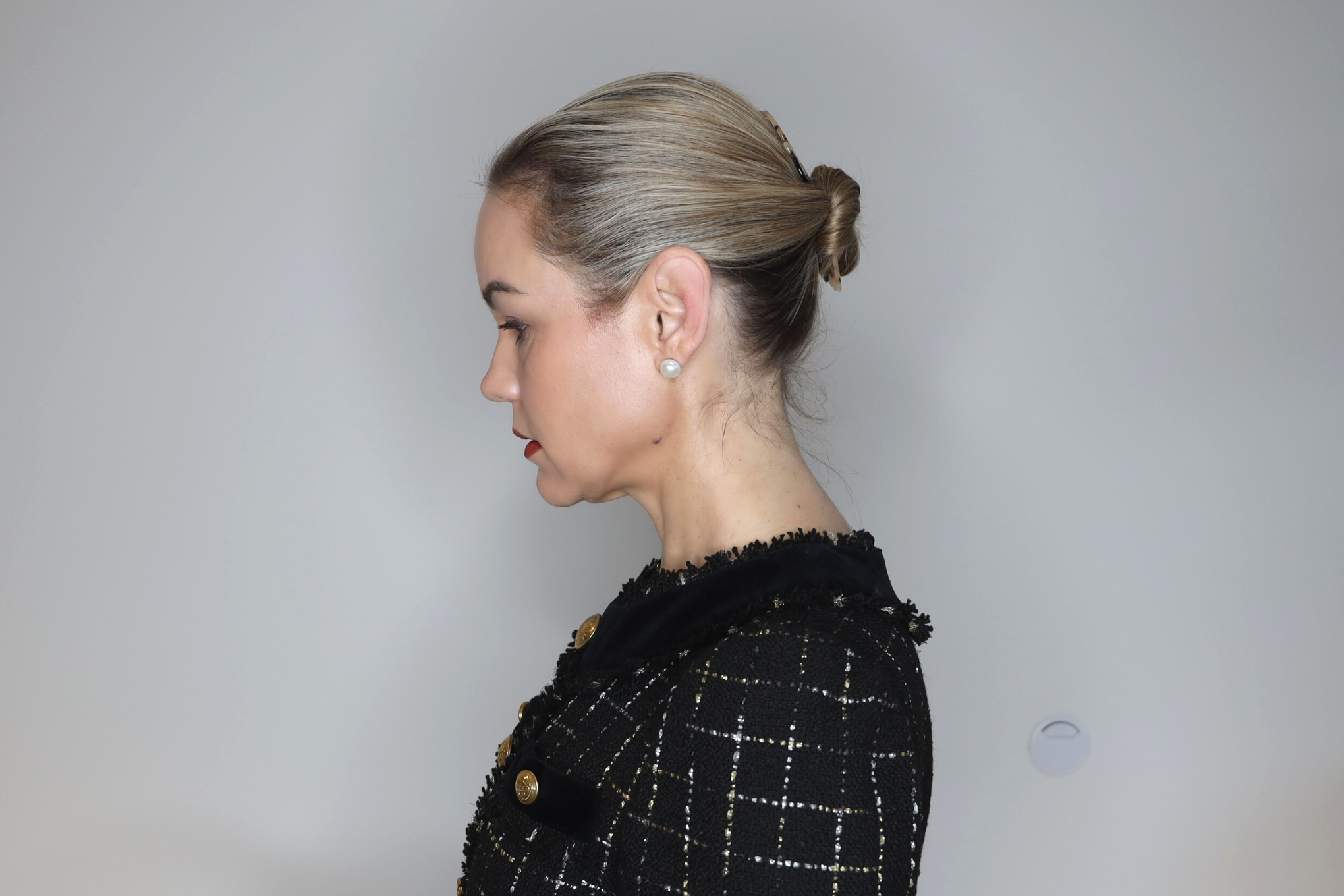
If your chin creates an obtuse angle with your neck, you can appear haughty or imperious.
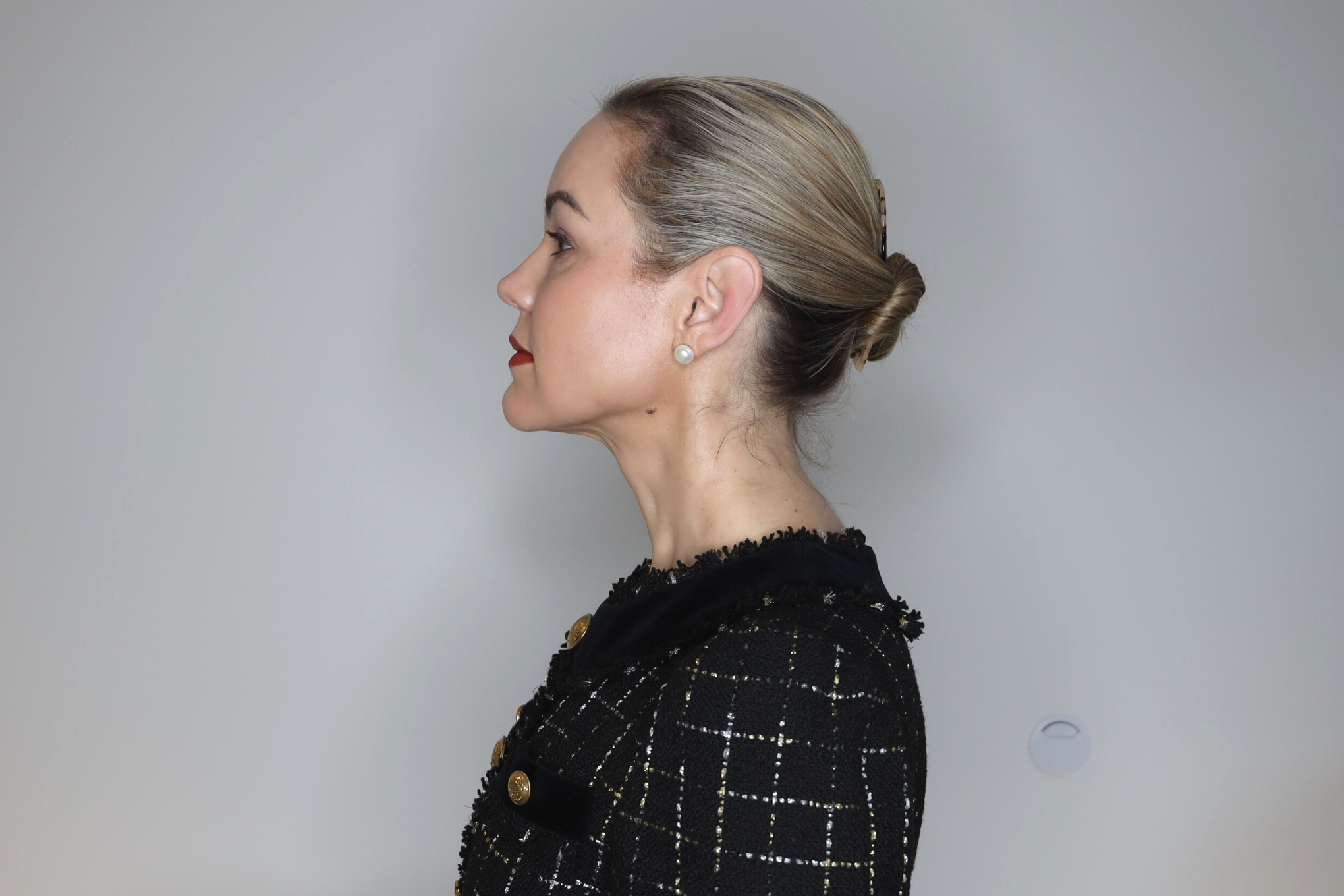
Another cue for neck posture is your gaze. Gaze at a parallel point directly in front of you. This is an excellent cue to align neck symmetry. If your gaze drops, your head and neck are likely to fall downwards which will skew balance and reduce openness and warmth.
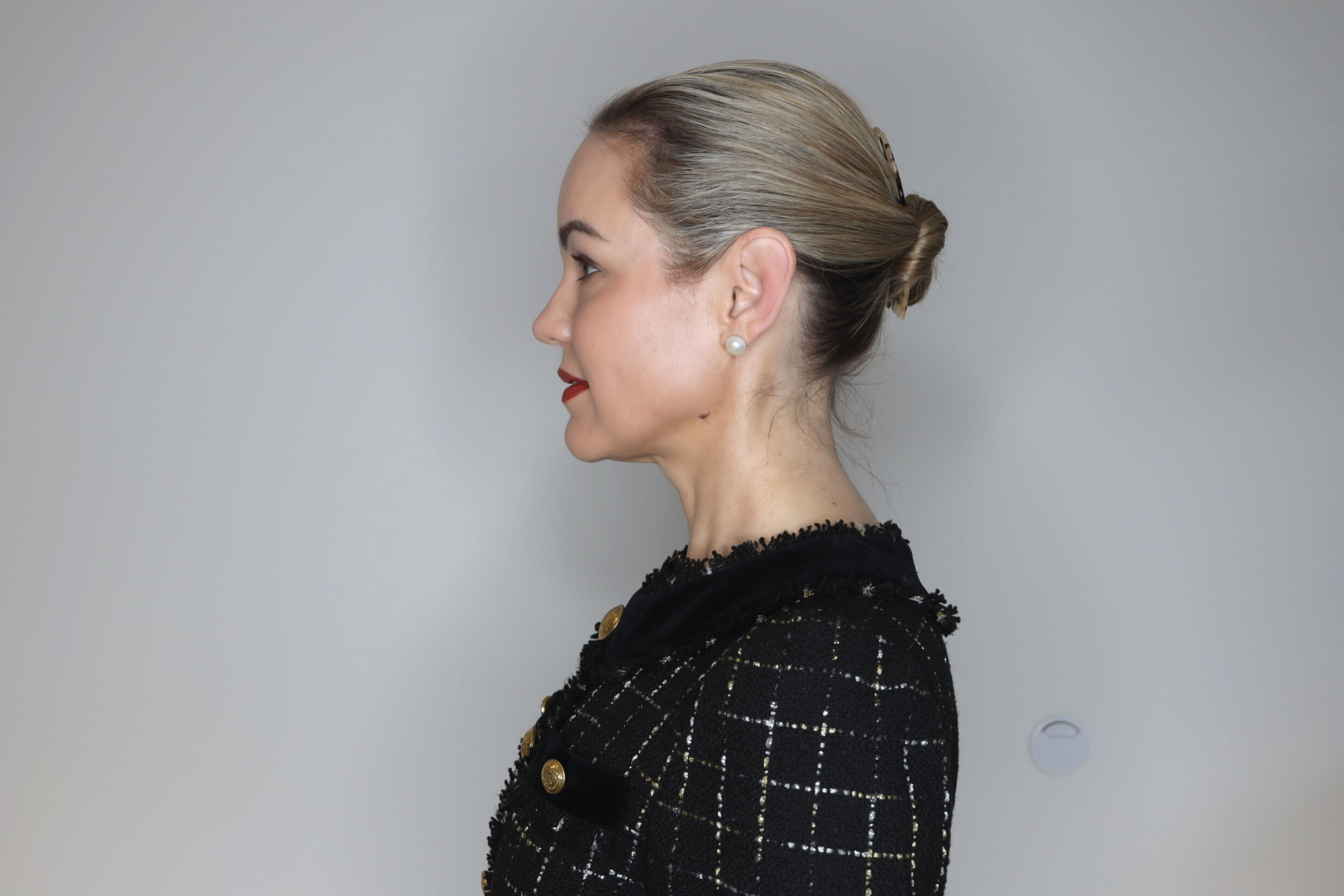
The Head
Let’s check head alignment. You should carry your head in a neutral position. Take care that it doesn’t tilt to one side, especially when presenting. Positioning your head in alignment as best as you can creates a clean and even canvas for clear facial cues that your conversation partner can read.
You can centre your head by aligning it with your sternum or breastbone. I like to imagine there is a line down the centre of my face that starts at the glabella (the area of skin between the eyebrows and above the nose). I then strive to achieve symmetry through the nose, the centre of the mouth and centre of the chin with the sternum. In doing so, you can carry your head with increased precision and present your gaze, your smile and expressions directly with your conversation partner.
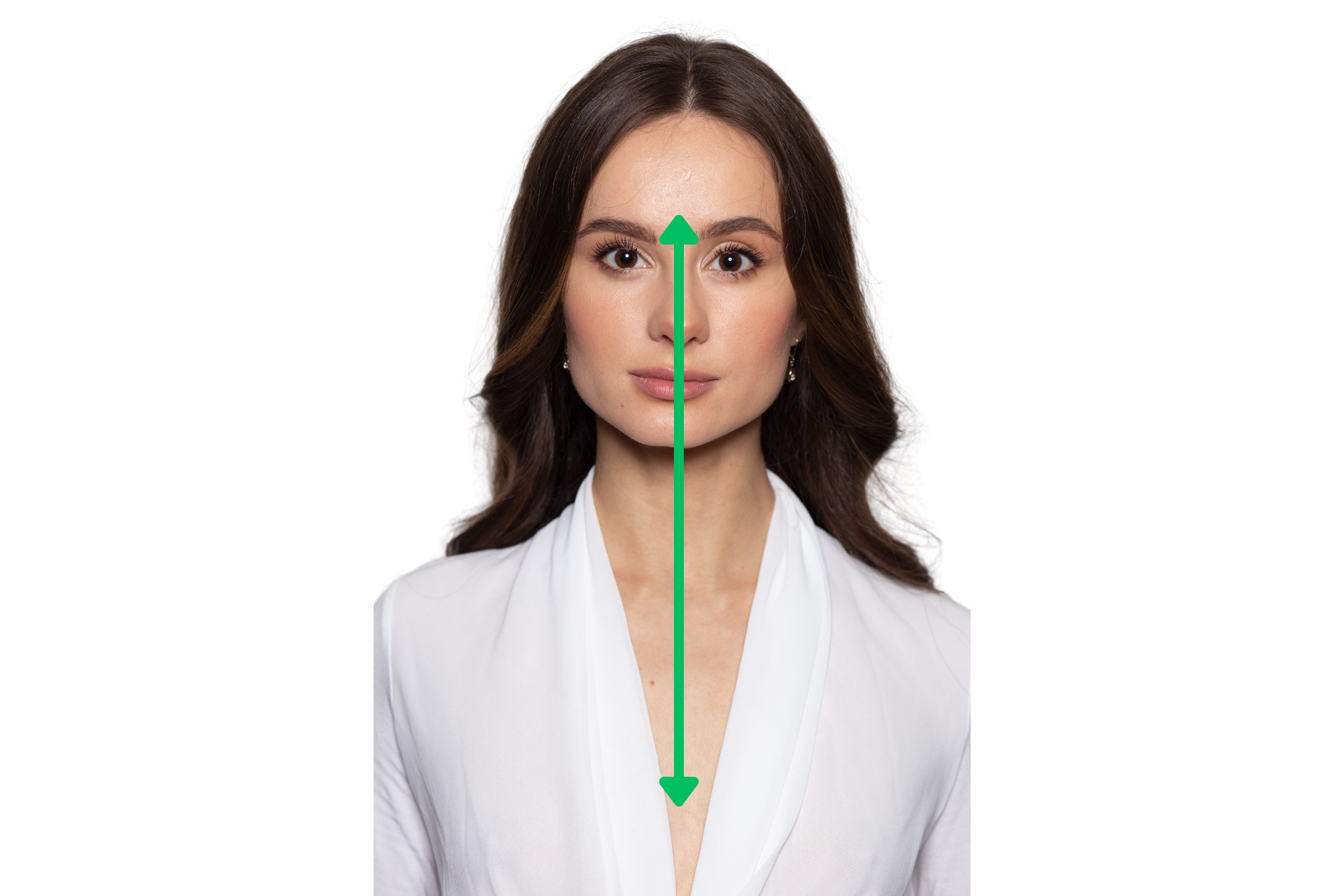
How Perfecting your Posture will impact positively on your wellbeing at Work according to research
Today we examined how to carry yourself to appear poised, elegant and confident. Think of your posture as the way you hold yourself. It’s not just about sitting straight; it’s about showing up with confidence. Imagine your body as a sturdy structure that supports your professional image.
Indeed how you stand has been shown to have an impact on the socio-emotional state.
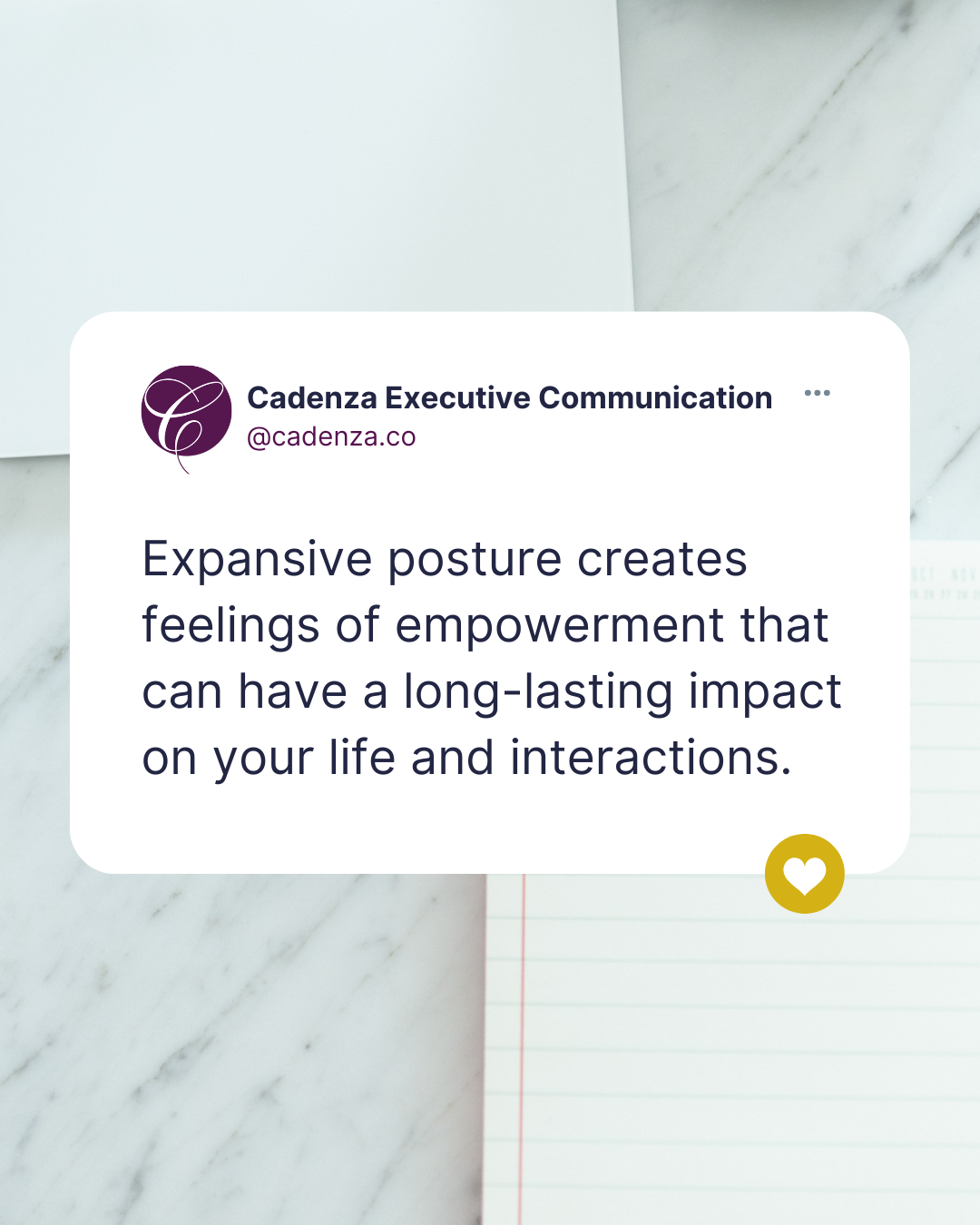
Research by Amy Cuddy and Jack Schultz released in the Journal, Psychological science in 2018 uncovered that “expansive posture impacts directly on your emotions, affect, mood recovery, as well as retrieval and recall of positive versus negative memories, and self-evaluations” (Cuddy & Schutz et al. 2018).
You can use these posture cues that I’ve provided today in your daily practice to increase your muscle memory for an expansive, confident and approachable stance. We all have different body shapes, tendencies and structural variations. Despite our tense points or asymmetries, it’s good to do something daily for your posture for health as much as for your communication. We all have challenges supporting our body positioning for health and confident presentation at work, especially with our busy lifestyles. I strongly recommend investing in your posture daily.
Find an activity, set of drills or exercise routine that enhances your skeletal system, muscular strength, flexibility, and stability and do something every day to counteract the harsh impacts our modern life, screen use and heightened stress levels place on posture.

Take our Free Masterclass
How to Look, Sound, and Feel Confident at Work
Discover the hidden tricks no one is talking about, which fast-track speaking confidence & executive presence at work.
To spread the joy of communicating without apology, I built out this instant Masterclass ready for you to watch. So join me in this FREE communication course delivered as a masterclass in which you’ll learn the science-backed strategies for ensuring your personal impact hits the mark at work so that you can have more influence and finally feel more confident.
THIS CLASS IS A PRIORITY-WATCH IF…
- You feel like your personality sometimes holds you back from speaking confidently at work
- You don’t know exactly what your communication at work needs, but you know it needs to change fast.
- You can’t pin what it is that prevents you from securing a promotion or leadership opportunity and need to increase your executive presence.
- Your voice tone doesn’t work for you reliably, leaving you sounding hesitant and nervous when under pressure.
- You admire charismatic communicators and wish you could engage and inspire the way they do.
- Difficult conversations at work shake your confidence and you want some strategies to control your responses with polish.
Feel free to share this event with your friends & colleagues!
References
-
Abele, A. E. and V. Yzerbyt (2021). “Body posture and interpersonal perception in a dyadic interaction: A Big Two analysis.” European Journal of Social Psychology 51(1): 23-39.
-
Cuddy, A. J. C., Schultz, S. J., & Fosse, N. E. (2018). P-Curving a More Comprehensive Body of Research on Postural Feedback Reveals Clear Evidential Value for Power-Posing Effects: Reply to Simmons and Simonsohn (2017). Psychological Science, 29(4), 656–666. https://doi.org/10.1177/0956797617746749
-
Friedlander, C. Complete Vocal Fitness: A Singer’s Guide to Physical Training, Anatomy, and Biomechanics Lanham, MD: Rowman & Littlefield, 2018.
Did you enjoy this post? Make sure to subscribe to our YouTube channel to get more content to increase your communication skills!
About the Author
Dr Sarah Lobegeiger de Rodriguez is a Keynote Speaker, Executive Speaking Coach, and Opera Singer who likes to play with words, sounds, and your impact.
Her academic background is in Music Performance, Communication Science and Speech & Language Pathology. She assists executive communication clients all over the world as a communication consultant with strong expertise in CEO, Founder and Entrepreneur communication strategies.
Connect with Sarah on LinkedIn.
© CADENZA
Level 14, 380 St Kilda Road, Melbourne, 3004
Privacy Policy
Terms & Conditions
Position Statement on Racism

